Abstract
A simple and straightforward approach to prepare TiO2-coated carbon nanotubes (CNTs) is presented. Anatase TiO2 nanoparticles (NPs) with the average size ~8 nm were coated on CNTs from peroxo titanic acid (PTA) precursor even at low temperature of 100 °C. We demonstrate the effects of CNTs/TiO2 molar ratio on the adsorption capability and photocatalytic efficiency under UV–visible irradiation. The samples showed not only good optical absorption in visible range, but also great adsorption capacity for methyl orange (MO) dye molecules. These properties facilitated the great enhancement of photocatalytic activity of TiO2 NPs-coated CNTs photocatalysts. The TiO2 NPs-coated CNTs exhibited 2.45 times higher photocatalytic activity for MO degradation than that of pure TiO2.
Keywords: TiO2, Carbon nanotubes, Nanoparticles, Photocatalyst, Methyl orange
Introduction
TiO2 has been one of the most widely investigated and used materials over the past decades [1-3], because it is nontoxic, easy to be made, inexpensive and chemically stable. In recent years, TiO2-based nanomaterials have attracted significant research attention due to their broad applications in the fields of water and air purification [4,5], H2 production [6,7], and photovoltaic and photoelectrochemical cells [8,9].
However, one of the major factors that limit the efficiency of TiO2 photocatalysis is its fast recombination of photo-generated electron/hole pairs, which releases energy in the form of unproductive heat or photons. To solve this problem, many efforts have been made to reduce charge recombination and enhance photocatalytic activity of TiO2[10]. Recently, synthesis of TiO2-CNTs composites has also attracted significant attention to increase the photocatalytic efficiency of TiO2[11-21]. Synthetic methods of TiO2-CNTs composites include sol–gel [16], chemical vapor deposition (CVD) [18,19], hydrothermal deposition [20], electrospinning technique [21], etc. Most of the composite materials exhibited better photocatalytic performances than pure TiO2 because they provide a large surface area and prevent charge recombination by trapping photo-excited electrons generated from TiO2. Furthermore, due to the conducting properties of CNTs, electrons that are transferred from TiO2 to CNTs could move freely along CNTs and thus the oxidative reactivity is enhanced. For example, CNTs coated with TiO2 exhibit higher photodegradation efficiency for phenol [22] and better photocatalytic inactivation of bacterial endospores [23] than CNTs or TiO2 alone.
However, most of the synthetic approaches of CNTs-TiO2 composites require special or expensive devices [18,21], or high temperature process [19,24]. Herein, we present a very simple and straightforward wet chemical process to synthesize composites comprising anatase TiO2 NPs-coated CNTs, which can be prepared at low temperature of 100 °C. By varying the ratio of TiO2/CNTs, a series of composites were prepared in order to optimize the synthetic condition of the TiO2 NPs-coated CNTs composites that exhibit the best photocatalytic activity. The photocatalytic property of the products was evaluated by degradation of MO under UV–visible irradiation.
Experimental
Synthesis of TiO2 NPs-coated CNTs
A simple strategy was designed for the preparation of TiO2NPs-coated CNTs, using peroxo titanic acid (PTA) as precursor of TiO2. PTA solution was prepared using the same chemical route as reported elsewhere [25]. The reagents CNTs, titanium tetrachloride (TiCl4), and ammonia solution were purchased from Hanwha Nanotech Corp., Sigma–Aldrich, and Junsei chemical, respectively. The process could be schematically displayed in Scheme 1. Briefly, CNTs was mixed with PTA solution under strong magnetic stirring and ultrasonic dispersion (Scheme 1a). The mixture was then heated at 100 °C for 24 h in a temperature-controlled oil bath equipped with a magnetic stirrer and a reflux condenser. During the heat treatment, PTA adsorbed on CNTs surface could be transformed to anatase TiO2 (Scheme 1b). Finally, the resulted dark precipitates were filtered and dried at 60 °C for 24 h to obtain the TiO2 NPs-coated CNTs nanocomposites (Scheme 1c). For the comparison, pure TiO2 NPs were also prepared using the same wet chemical process without an addition of CNTs.
Scheme 1.
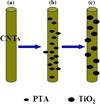
Schematic illustration of the formation process of TiO2 NPs-coated CNTs
Characterization
The crystal structure of the samples was investigated by using powder X-ray diffraction (XRD) and Raman spectra. XRD was performed with Cu Kα radiation on a D/MAX-RB X-ray diffractometer (Rigaku, Japan), and Raman analysis was performed on a LabRAM HR instrument (Horiba Jobin–Yvon, France) in air environment. The morphologies and size of the samples were investigated using a Tecnai G2 F30 field emission transmission electron microscope (FETEM, FEI). UV–visible diffuse reflectance spectra (UV–Vis DRS) were performed on a S4100 UV–Vis spectrophotometer.
Photocatalytic Activity Measurements
Photocatalytic decomposition of MO was examined by optical absorption spectroscopy. Typically, 10 mg of photocatalyst was put into 40.0 mL of MO aqueous solution (10 mg/L) in a 50-mL beaker. Prior to irradiation, the mixture was ultrasonicated in a water bath for 2 min to ensure good dispersion of the photocatalysts. Subsequently, the mixture was stirred in darkness for 20 min in order to establish adsorption/desorption equilibrium between MO molecules and the surface of the photocatalysts. The mixture was then illuminated with a 500-W Xe lamp under a magnetic stirring. The solution of 2.0 mL was drawn out, and the MO solution was separated from the photocatalysts by centrifugation to determine the concentration of MO using a S4100 UV–Vis spectrophotometer.
Results and Discussion
Photocatalyst Characterization
TEM images of the as-synthesized samples are shown in Fig. 1. The selected area electron diffraction (SAED) pattern (Fig. 1a, inset) shows polycrystalline diffraction rings, which are indexed to (101), (004), (200) and (105) planes of anatase TiO2. The particle size of the TiO2 on the surface of CNTs is ~8 nm (Fig. 1c). In addition, the measured lattice distance of 0.35 nm (Fig. 1b, 1d) is a good agreement with (101) lattice distance of anatase TiO2. These results indicate that anatase TiO2 NPs-coated CNTs have been successfully synthesized under low temperature of 100 °C.
Figure 1.
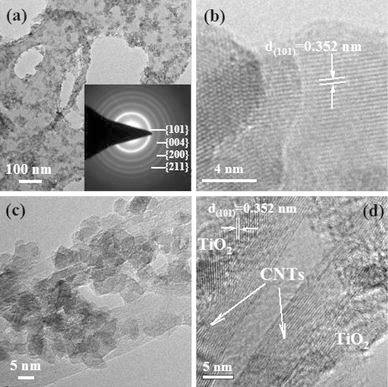
TEM image of TiO2 NPs-coated CNTs (a), and HRTEM images of pure TiO2 (b) and anatse TiO2 NPs-coated CNTs (c, d)
It has been reported [26] that six Raman active modes for anatase TiO2, A1g + 2B1g + 3Eg, could be detected at 144 cm−1 (E.g.), 197 cm−1 (E.g.), 399 cm−1 (B1g), 513 cm−1 (A1g), 519 cm−1 (B1g), and 639 cm−1 (E.g.), and the peaks at 250, 450, and 620 cm−1 are due to the Ti–O–Ti bond of rutile spectrum. Raman spectra provided by Fig. 2 indicate the presence of anatase TiO2 for all the samples synthesized with different CNTs/TiO2 M ratios. The two weak peaks centered at around 1,347 and 1,580 cm−1 are due to CNTs [27], which cannot be observed for pure TiO2 (Fig. 2, inset, below right). In addition, the peak corresponding to the E1g mode of anatase TiO2 significantly shift from ~148 to 155 cm−1 compared with that of pure TiO2 (Fig. 2, inset, upper left). It has been reported that such a blue shift could be attributed to phonon confinement caused by a decrease in crystal size of anatase [28] or an increased surface strain of TiO2 caused by the adsorption of surfactants [29]. In our study, the size of TiO2 NPs is calculated to be around 8 nm, which will be further discussed later. Consequently, the blue shift of Raman peak might be caused by CNTs, which act a similar effect as surfactant. Comparatively, the ratio of peak intensity between TiO2 and CNTs increases with the decreasing CNTs/TiO2 molar ratios, which indicates that the concentration of TiO2 increased within the samples.
Figure 2.
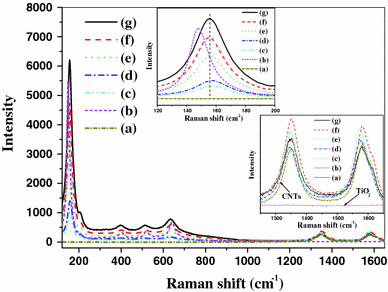
Raman spectra of pure CNTs (a), TiO2 (b), and TiO2 NPs-coated CNTs synthesized with CNTs/TiO2 molar ratio of 4/1 (c), 2/1 (d), 1/1 (e), 1/2 (f) and 1/4 (g)
Figure 3 displays the XRD pattern of pure TiO2 and TiO2 NPs-coated CNTs nanocomposites. As depicted in Fig. 3a, 3c, the diffraction peaks at 2θ = 25.2°, 37.8°, 47.9°, 54.0° and 62.6° match exactly with (101), (004), (200), (105) and (204) reflections of anatase TiO2 (JCPDS: 21-1272). The characteristic peaks for CNTs at the positions of 2θ = 25.9° and 43.2° are observed for pure CNTs sample (Fig. 3b), which is similar with the results reported elsewhere [30]. However, the peak at 2θ = 25.9° cannot be found clearly in the TiO2 NPs-coated CNTs except the weak peak at 2θ = 43.2° (Fig. 3c). This is because the main peak of CNTs at 2θ = 25.9° is overlapped by that of anatase TiO2 at 2θ = 25.2°. The peaks of anatase TiO2 tend to shield those of CNTs, for the crystalline extent of TiO2 is stronger than that of CNTs. This could be observed from the comparison of XRD peak intensity between pure TiO2 (Fig. 3a) and pure CNTs (Fig. 3b). In addition, the average crystal diameter of the pure TiO2 (Fig. 3a) was found to be ~8 nm from the XRD patterns, which was calculated from the largest XRD peak centered at 2θ = 25.2° by the well-known Scherrer’s equation.
Figure 3.
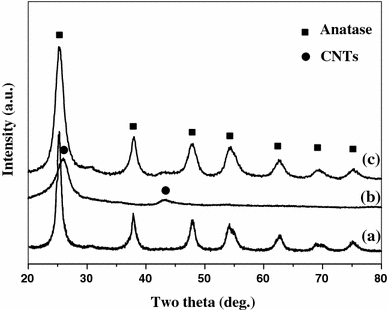
XRD patterns of pure TiO2 (a), CNTs (b) and TiO2 NPs-coated CNTs (c)
Figure 4 provides the UV–vis DRS spectra of the synthesized samples. One can observe that pure TiO2 exhibit band-edge absorptions around 387 nm (Fig. 4a) typically for anatase phase. However, pure CNTs display absorbance over the entire visible light region. Besides the band-edge absorption around 387 nm, additional wide optical absorptions in visible light region are also observed for TiO2 NPs-coated CNTs. Figure 4 also indicates that the spectral absorbance of the TiO2 NPs-coated CNTs increased generally with the increasing of CNT content, which might be associated with the absorption of CNTs. This visible light absorbance property can facilitate the enhancement of photocatalytic property of the TiO2-based nanomaterials.
Figure 4.
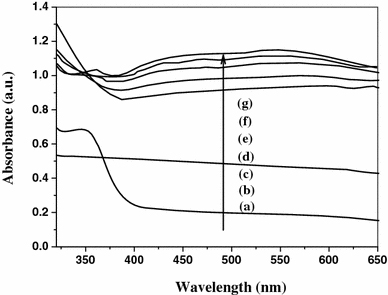
UV–vis DRS of pure TiO2 (a), CNTs (b) and TiO2 NPs-coated CNTs synthesized with CNTs/TiO2 molar ratio of 1/4 (c), 1/2 (d), 1/1 (e), 2/1 (f), and 4/1 (g)
Photocatalytic Activity of the TiO2 NPs-coated CNTs
Figure 5 confirms the photodecomposition of dye MO on pure TiO2 and TiO2 NPs-coated CNTs photocatalysts. Pure CNTs showed little photocatalytic activity (Fig. 5a), and pure TiO2 showed only 32.8% photocatalytic decomposition for MO after 10 min of irradiation (Fig. 5b). As can be seen from Fig. 5c–5g, the molar ratio of CNTs/TiO2 affects greatly the photocatalytic activity. Generally the photocatalytic activity increases initially and decreases with increasing the molar ratio of CNTs/TiO2. Among all of the photocatalysts, the samples prepared with CNTs/TiO2 molar ratio of 1:1 exhibits the highest photodegradation efficiency with a MO conversion of 80.5% after 10 min of irradiation (Fig. 5e), which is 2.45 times higher than that of pure TiO2.
Figure 5.
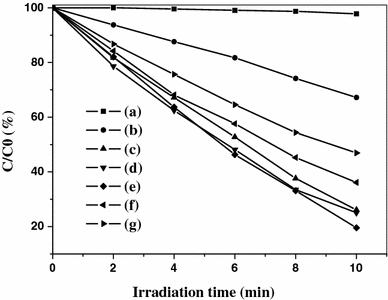
Photodegradation of MO solutions over CNTs (a), TiO2 (b) and TiO2 NPs-coated CNTs synthesized with CNTs/TiO2 molar ratio of 1/4 (c), 1/2 (d), 1/1 (e), 2/1 (f) and 4/1 (g). C0 and C is the initial concentration of MO before irradiation and after irradiation for a period of time, respectively
It has been widely accepted that photocatalytic properties of TiO2-based catalysts are governed by various parameters, such as surface area, particle size, and the surface hydroxyl groups. First of all, CNTs provide a large surface area to enhance the adsorption capability for dye molecules. Figure 6 provides the UV–Vis absorption spectra of MO solution over various samples, before (Fig. 6A) and after (Fig. 6B) the irradiation with a Xe lamp. A decrease in the concentration occurred after the samples were dispersed into the MO aqueous solution and subsequently stirred for 20 min in darkness, revealing that parts of the MO molecules were adsorbed on the surface of samples. In addition, the adsorption capability of TiO2 NPs-coated CNTs was enhanced with increasing the CNT content (Fig. 6A). Especially, pure CNTs exhibited the highest adsorption capacity. This strong adsorption property for dye molecules could affect the photocatalytic activity of TiO2-based samples. However, excess amount of CNTs would shield TiO2 from absorbing light and thus weaken the photocatalytic efficiency. Second, it was reported that the relative position of the CNT conduction band edge permit the transfer of electrons from the anatase TiO2 surface to CNT, allowing charge separation and consequently reducing recombination of photo-excited electron/hole pairs [11]. Last, CNTs facilitate the adsorption of more hydroxyl group on the surface of the TiO2 NPs-coated CNTs composites [31], which benefit for photocatalysis. All of these properties account for the highest photocatalytic efficiency for TiO2 NPs-coated CNTs with CNTs/TiO2 molar ratio of 1:1.
Figure 6.
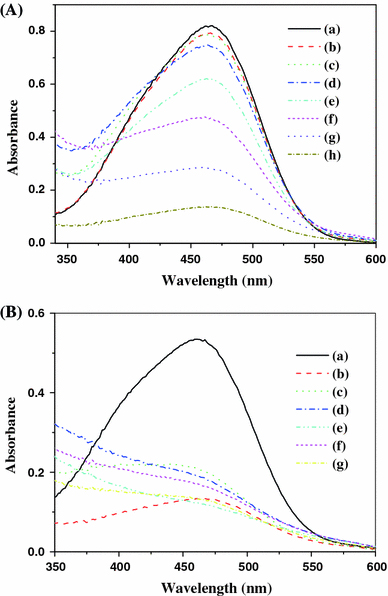
A Absorption spectra of original MO solution of 10 mg/L (a) and MO solution before irradiation over various samples: pure TiO2 (b), TiO2 NPs-coated CNTs with CNTs/TiO2 molar ratios of 1/4 (c), 1/2 (d), 1/1 (e), 2/1 (f), and 4/1 (g), and pure CNTs (h). B Absorption spectra of MO solution after 10 min of irradiation over various samples: pure TiO2 (a), pure CNTs (b), and TiO2 NPs-coated CNTs with CNTs/TiO2 molar ratios of 1/4 (c), 1/2 (d), 1/1 (e), 2/1 (f), and 4/1 (g)
Conclusion
We have demonstrated that composites of anatase TiO2 NPs-coated CNTs can be straightforwardly prepared by a simple wet chemical method. The molar ratio of CNTs/TiO2 affects the adsorption capability of the final products, and consequently influences the photocatalytic activity. By optimization, TiO2 NPs-coated CNTs sample with CNTs/TiO2 molar ratio of 1:1 exhibits 2.45 times higher efficiency than that of pure TiO2 NPs. The present chemical method is much simpler than previous-reported methods including CVD and electrospinning technique, and is suitable for large-scale production. Because of the efficient adsorption capability and prominent photodegradation efficiency, the anatase TiO2 NPs-coated CNTs might be used for other desired applications, such as photovoltaic and photochemical cells, sensor, and hydrogen production.
Acknowledgments
This work was supported by the Korea Science and Engineering Foundation (KOSEF) grant funded by the Korea Ministry of Education, Science and Technology (MEST) (No. 2009-0081819).
Open Access
This article is distributed under the terms of the Creative Commons Attribution Noncommercial License which permits any noncommercial use, distribution, and reproduction in any medium, provided the original author(s) and source are credited.
References
- Fujishima A, Honda K. Nature. 1972. p. 37. COI number [1:CAS:528:DyaE38XltVykurw%3D]; Bibcode number [1972Natur.238...37F] [DOI] [PubMed]
- Yang HG, Sun CC, Qiao SZ, Zou J, Liu G, Smith SC, Cheng HM, Lu GQ. Nature. 2008. p. 638. COI number [1:CAS:528:DC%2BD1cXmsVKqtbk%3D]; Bibcode number [2008Natur.453..638Y] [DOI] [PubMed]
- Buonsanti R, Grillo V, Carlino E, Giannini C, Kipp T, Cingolani R, Cozzoli PD. J. 2008. p. 11223. COI number [1:CAS:528:DC%2BD1cXovVWis7k%3D] [DOI] [PubMed]
- Suprabha T, Roy HG, Thomas J, Kumar KP, Mathew S. Nanoscale Res. 2009. p. 144. COI number [1:CAS:528:DC%2BD1MXht1Knsbg%3D]; Bibcode number [2009NRL.....4..144S] [DOI] [PMC free article] [PubMed]
- Cappelletti G, Ardizzone S, Bianchi CL, Gialanella S, Naldoni A, Pirola C, Ragaini V. Nanoscale Res. 2009. p. 97. COI number [1:CAS:528:DC%2BD1MXht1Knsb4%3D]; Bibcode number [2009NRL.....4...97C] [DOI] [PMC free article] [PubMed]
- Petrik NG, Kimmel GA. J. Phys. Chem. C. 2009. p. 4451. COI number [1:CAS:528:DC%2BD1MXitFyltr0%3D] [DOI]
- Dai K, Peng T, Ke D, Wei B. Nanotechnology. 2009. p. 125603. Bibcode number [2009Nanot..20l5603D] [DOI] [PubMed]
- Yu KH, Chen JH. Nanoscale Res. 2009. p. 1. COI number [1:CAS:528:DC%2BD1MXht1Kgs7w%3D]; Bibcode number [2009NRL.....4....1Y] [DOI]
- Law M, Greene LE, Johnson JC, Saykally R, Yang PD. Nat. 2005. p. 455. COI number [1:CAS:528:DC%2BD2MXks1Cit7o%3D]; Bibcode number [2005NatMa...4..455L] [DOI] [PubMed]
- Wang CM, Heller A, Gerischer H. J. 1992. p. 5230. COI number [1:CAS:528:DyaK38XktVOgsbw%3D] [DOI]
- Yao Y, Li G, Ciston S, Lueptow RM, Gray KA. Environ. 2008. p. 4952. COI number [1:CAS:528:DC%2BD1cXmtFWgtr4%3D] [DOI] [PubMed]
- Liu B, Zeng HC. Chem. 2008. p. 2711. COI number [1:CAS:528:DC%2BD1cXjsVWgtro%3D] [DOI]
- Kuo CS, Tseng YH, Lin HY, Huang CH, Shen CY, Li YY, Shah SI, Huang CP. Nanotechnology. 2007. p. 465607. Bibcode number [2007Nanot..18T5607K] [DOI] [PubMed]
- Eder D, Windle AH. Adv. 2008. p. 1787. COI number [1:CAS:528:DC%2BD1cXmslWjs7c%3D] [DOI]
- Song HQ, Qiu XP, Li FS, Zhu WT, Chen LQ. Electrochem. 2007. p. 1416. COI number [1:CAS:528:DC%2BD2sXlslGiur0%3D] [DOI]
- Gao B, Chen GZ, Puma GL. Appl. 2009. p. 503. COI number [1:CAS:528:DC%2BD1MXmtleqsbc%3D] [DOI]
- Chen LC, Ho YC, Guo WS, Huang CM, Pan TC. Electrochim. Acta. 2009. p. 3884. COI number [1:CAS:528:DC%2BD1MXktlGht7o%3D] [DOI]
- Yu HT, Quan X, Chen S, Zhao HM, Zhang YB. J. 2008. p. 301. COI number [1:CAS:528:DC%2BD1cXhsVWjsr7K] [DOI]
- Orlanducci S, Sessa V, Terranova ML, Battiston GA, Battiston S, Gerbasi R. Carbon. 2006. p. 2839. COI number [1:CAS:528:DC%2BD28XoslGnsb4%3D] [DOI]
- Sainsbury T, Fitzmauriceand D. Chem. 2004. p. 3780. COI number [1:CAS:528:DC%2BD2cXntVCku7o%3D] [DOI]
- Shahar K, Judith S, Yaron P, Yachin C. Langmuir. 2005. p. 5600. [DOI] [PubMed]
- Wang W, Serp P, Kalck P, Faria JL. Appl. Catal. B. 2005. p. 305. COI number [1:CAS:528:DC%2BD2MXhslegtrY%3D] [DOI]
- Lee SH, Pumprueg S, Moudgil B, Sigmund W. Colloids Surf. B. 2005. p. 93. COI number [1:CAS:528:DC%2BD2MXitVagtQ%3D%3D] [DOI] [PubMed]
- Yang YD, Qu LT, Dai LM, Kang T-S, Durstock M. Adv. 2007. p. 1239. [DOI]
- Xie Y, Zhao QN, Zhao XJ, Li YZ. Catal. 2007. p. 231. COI number [1:CAS:528:DC%2BD2sXhtV2itbvN] [DOI]
- Mikami M, Arakanura S, Kitao O, Arakwa H. Phys. Rev. B. 2002. p. 155213. Bibcode number [2002PhRvB..66o5213M] [DOI]
- Wang S, Ji LJ, Wu B, Gong QM, Zhu YF, Liang J. Appl. 2008. p. 3263. COI number [1:CAS:528:DC%2BD1cXhsVChsrbL]; Bibcode number [2008ApSS..255.3263W] [DOI]
- Bersani D, Lottici PP, Ding X-Z. Appl. 1998. p. 73. COI number [1:CAS:528:DyaK1cXhvFGltg%3D%3D]; Bibcode number [1998ApPhL..72...73B] [DOI]
- Xu CY, Zhang PX, Yan L. J. 2001. p. 862. COI number [1:CAS:528:DC%2BD3MXnslKju74%3D]; Bibcode number [2001JRSp...32..862X] [DOI]
- Lee SW, Sigmund WM. Chem. 2003. p. 780. [DOI] [PubMed]
- Yu Y, Yu JC, Yu JG, Kwok YC, Che YK, Zhao JC, Ding L, Ge WK, Wong PK. Appl. 2005. p. 186. COI number [1:CAS:528:DC%2BD2MXmt1Sqtrg%3D] [DOI]


